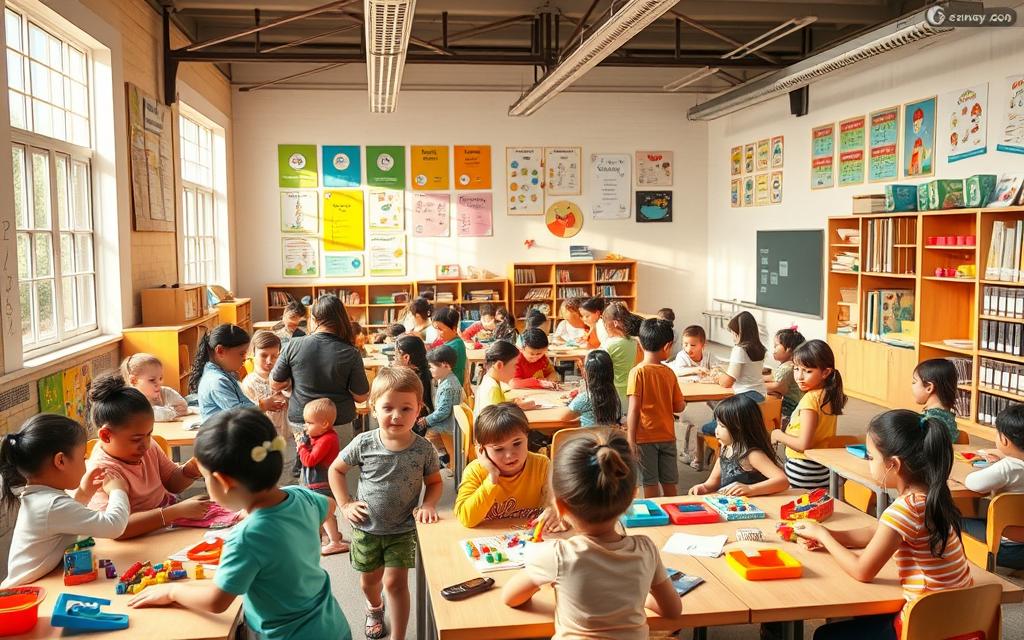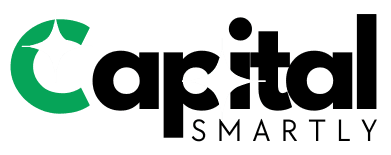advertisement
Early childhood programs are key for kids from birth to age eight. This article looks at early learning and preschool programs. It shows how they help with thinking, feeling, and growing.
Research from the National Institute for Early Education Research and others shows lasting benefits. Child development programs help kids get ready for school, do better in school, and earn more later in life. They also help kids avoid special education and graduate more often.
These findings are important for parents, teachers, and policymakers in the U.S. The quality, access, and family involvement in programs affect these benefits. This article will dive into different programs, what makes them good, the role of families, funding, and more.
Important terms include early childhood programs, early learning, preschool, and more. These terms and the research will help readers make smart choices about early education.
What are Early Childhood Programs?
Early childhood programs support kids from birth to early elementary years. They help with development, health, learning, and family well-being. This is done through organized settings and home-based supports.
Definition of Early Childhood Programs
These programs include center-based care, home visiting, family child care, and school-linked services. They focus on important milestones and skills like language, math, and social skills. They also work on health and nutrition.
Many programs team up with pediatricians and social services. This helps support families and track how kids are doing.
Types of Early Childhood Programs
Center-based preschools and child care settings offer Head Start, state pre-K, private preschools, and community early childhood centers. These places focus on preschool education and getting ready for kindergarten.
Infant and toddler programs are for kids under three. They focus on caregiving, building a secure bond, and stimulation. This supports brain development in the earliest months and years.
Early intervention services help with developmental delays and disabilities. They include services under IDEA Part C and therapies like speech, occupational, and physical therapy.
Home visiting and family support programs, like Nurse-Family Partnership and Parents as Teachers, help caregivers. They also connect families to resources. Mixed-delivery systems use public funding and community providers to offer more choices and access.
Programs vary in how they reach and serve families. Universal pre-K aims for wide access. Targeted models like Head Start focus on low-income families and offer more support.
Success depends on quality, how much time kids spend in the program, and how well it’s done. Studies show that high-quality programs for infants and toddlers, and full-day preschool, lead to better development. This is more than lower-dose options.
Importance of Early Childhood Education
Early experiences shape our brains quickly in the first five years. Neuroscience shows our brains are very flexible during this time. This means quality programs can shape our future learning and behavior.
Policymakers say investing in early learning pays off in the short and long term. They use the National Academies to support this claim.
Programs for young children focus on social skills and self-control. They learn to share, take turns, and solve conflicts. Adults model calm behavior, helping children manage their emotions.
Quality preschool education boosts self-regulation and executive function. Structured play and routines improve attention and memory. These skills are crucial for success in school and later life.
Supportive child development programs reduce problem behavior. Teachers see fewer issues and better peer relations in enrolled children. Families get screenings, nutrition, and support, reducing stress and improving behavior at home.
Language and early literacy grow with purposeful word and story exposure. Interactive reading and talking expand vocabulary and phonological awareness. These skills are essential for reading success in kindergarten and beyond.
Hands-on play drives early numeracy and problem-solving. Counting, patterns, and spatial exploration build number sense and reasoning. Playful instruction prepares children for math in the classroom.
Research shows high-quality kindergarten readiness programs lead to better reading and math scores. Meta-analyses confirm lasting benefits with well-designed programs. Expanding access to preschool education can narrow income gaps by offering enrichment and health supports.
| Area | Key Benefit | Typical Program Element |
|---|---|---|
| Social Development | Improved cooperation and emotion regulation | Small-group play, conflict-resolution coaching |
| Executive Function | Better attention and inhibitory control | Structured routines, memory games |
| Language & Literacy | Expanded vocabulary and phonological skills | Interactive read-alouds, dialogic questioning |
| Numeracy | Stronger number sense and spatial reasoning | Manipulative math play, pattern activities |
| Equity | Reduced achievement gaps | Comprehensive services, family engagement |
Key Components of Effective Early Childhood Programs
Good early childhood programs have clear quality areas. These include curriculum, teacher skills, how adults interact with kids, the learning space, family involvement, checking progress, and health and nutrition. All these parts work together to help young kids learn and grow.
Curriculum and Learning Standards
A good early childhood curriculum is based on research and fits the child’s age. Programs like HighScope and Creative Curriculum mix child-led play with planned lessons. They follow state guidelines and the Head Start Early Learning Outcomes Framework for a consistent approach.
Checking progress and adjusting lessons is key. Tools like Teaching Strategies GOLD and CLASS help teachers see how kids are doing. This way, lessons can be made to fit each child’s needs.
Qualified and Caring Educators
Teachers’ skills and ongoing learning are crucial. Educators with early childhood degrees and training do better. Their interactions with kids, like being sensitive and using rich language, help kids learn and behave better.
Teachers’ work conditions also matter. Good pay, small class sizes, and support help keep them. This stability is good for kids’ learning and growth.
The classroom environment is also important. It should have low student-to-teacher ratios, safe areas, and materials that fit the culture. Services like health checks, nutrition, and family support make programs complete.
The Role of Family in Early Childhood Education
Families are the first teachers. Parents, grandparents, and caregivers shape daily routines, language, and emotional security. Working together with families strengthens early childhood programs and supports long-term child growth.
Effective family engagement needs clear strategies. Programs like Parents as Teachers and Head Start use home visits, workshops, and coaching. These methods build trust and share practical skills, linking classroom learning to home life.
Practical supports help families participate more. Flexible scheduling, transportation help, and language access remove barriers. Resource referrals and community health or food program links reduce stressors that can hinder learning.
Home-based strategies work well. Take-home learning activities and regular family-teacher conferences are effective. Two-way communication systems let educators learn about family goals while offering tailored guidance. Tracking attendance and using short surveys helps measure engagement and refine outreach.
Language-rich interactions at home boost vocabulary and early literacy. Daily conversations, shared book reading, and storytelling are simple routines with big returns. These habits complement child development programs offered in centers.
Stability and routines support executive function. Regular sleep, predictable meals, and calm transitions help children manage emotions and focus in early childhood programs. When families struggle with economic hardship, early intervention services and family support programs can connect them to benefits and counseling.
Cultural responsiveness matters. Tailoring engagement to family values and involving extended family creates stronger partnerships. Coaches and teachers who respect cultural practices build trust and improve outcomes in child development programs.
| Family Engagement Strategy | What It Does | How It Links to Services |
|---|---|---|
| Home Visits | Builds trust, models routines, observes child in natural setting | Connects families to early intervention services and health referrals |
| Parent Workshops | Teaches literacy, behavior strategies, and nutrition tips | Reinforces child development programs and school readiness practices |
| Take-Home Activities | Encourages daily practice of skills through simple tasks | Bridges classroom goals with family routines and learning at home |
| Two-Way Communication | Shares progress, gathers family input, plans next steps | Aligns program goals with family priorities and referral needs |
| Practical Supports | Reduces barriers like transport, childcare, and language | Increases access to family support programs and community services |
Government Support for Early Childhood Programs
Federal and state governments play big roles in early childhood programs. They focus on helping low-income families and improving the quality of care. This effort aims to make sure all kids get a good start in life.

Federal Initiatives and Funding
The government supports preschool programs through several key funds. Head Start and Early Head Start offer help to young children. The Child Care and Development Fund helps families pay for childcare.
IDEA Part C helps infants with disabilities get early help. Congress has also talked about more money for preschool and for teachers in early childhood.
Goals include making more programs available, improving their quality, and better tracking how they do. Federal rules help guide these efforts and inform state decisions.
State-Level Programs and Policies
State programs for pre-K vary a lot. Some, like Florida’s Voluntary Pre-K, offer it to all who want it. Others, like Oklahoma’s, make it available to everyone.
States use different ways to fund these programs. Some pay for public schools, others for community centers or private schools. Quality Rating and Improvement Systems (QRIS) help improve these programs.
States have many ways to shape their programs. They can set rules for teachers, decide how much to pay for care, and collect data. This data helps them see what works best.
| Program or Policy | Primary Goal | Typical Funding Source | Common Outcome Measures |
|---|---|---|---|
| Head Start / Early Head Start | Comprehensive early education and family support | Federal appropriations | School readiness, health screenings, family services |
| Child Care and Development Fund (CCDF) | Child care affordability and parental employment | Federal block grants matched by states | Access to care, subsidy utilization, provider quality |
| IDEA Part C | Early intervention for infants and toddlers with disabilities | Federal and state funds | Developmental milestone progress, family outcomes |
| State Pre-K Programs | Universal or targeted preschool access | State budgets, local funds, mixed sources | Enrollment rates, class size, assessment gains |
| Quality Rating & Improvement Systems (QRIS) | Improve program quality and transparency | State and philanthropic grants | Quality tiers, teacher qualifications, child outcomes |
How Early Childhood Programs Prepare Children for School
Early childhood curriculum is key for a smooth kindergarten start. It mixes play, routine, and learning. This helps kids develop social skills, self-help, and basic school tools.
Working together, preschools and elementary schools make the transition easier. This reduces stress for kids and families.
Transition to Kindergarten
Transition work starts early. Kids visit schools to meet teachers and see classrooms. Preschools and elementary schools plan together to match expectations and routines.
They share data and meet to discuss strengths and needs. This helps families and keeps teachers on the same page. It lowers anxiety and boosts school engagement.
Developing Early Literacy and Numeracy Skills
Early literacy comes from talking, reading, and activities. Reading aloud and interactive stories build vocabulary. Alphabet and writing skills prepare kids for books and tasks.
Early math skills grow from counting, patterns, and play. Hands-on math and problem-solving questions help with numbers and measurement.
Screening tools help find kids who need extra help early. When preschools and schools work together, kids get a better start. Teachers also know how to support each child better.
Diverse Learning Environments in Early Childhood
Creating diverse learning environments means making classrooms where every child can feel at home and succeed. These classrooms mix typical early childhood programs with special supports. This way, children learn together. The key is in the design, the staff’s training, and working closely with families.
Law and policy set clear rules for inclusion. IDEA Parts B and C require early intervention services and special education in the least restrictive environment. Families get plans that guide goals, therapies, and classroom changes.
Inclusive programs use special supports, adapted materials, and therapies in daily routines. Special educators work with general teachers to make activities accessible. They also help peers learn to interact socially. Family plans make goals achievable and meaningful.
Research shows inclusive settings improve social skills and friendships. Children with disabilities make friends, learn to communicate, and grow alongside their classmates. Typical peers gain empathy and learn from different perspectives.
Inclusive Programs for Children with Special Needs
Start with an assessment and a written plan that links early intervention services to classroom goals. Use team meetings to align therapists, teachers, and families. Simple changes like visual schedules and flexible seating help many learners.
Professional development is key. Training in behavior supports and assistive technology boosts teacher confidence. Programs that work with local agencies offer extra support outside school hours.
Cultural Relevance in Curriculum
Culturally responsive teaching respects home languages, traditions, and community knowledge. Curriculum includes books and songs that reflect the children. This approach helps children feel connected and increases their interest in learning.
Dual-language strategies help children learn in their home language and English. Teachers trained in second-language acquisition use gestures and visual aids to help vocabulary growth.
Equity means reaching out to families who face barriers. Hire staff who understand different cultures and offer flexible enrollment. Materials and staffing that reflect the community help families trust programs and participate more.
| Area | Practical Steps | Expected Outcomes |
|---|---|---|
| Assessment & Planning | Use IFSP/IEP, team meetings, set measurable goals | Coordinated supports, clearer progress tracking |
| Classroom Adaptations | Visual schedules, sensory spaces, adapted materials | Increased participation, fewer behavior disruptions |
| Therapies & Services | Embed speech, OT, PT into routines; link to early intervention services | Smoother skill generalization, better daily functioning |
| Family Engagement | Home visits, family training, culturally relevant communication | Stronger home–school consistency, higher retention |
| Curriculum & Representation | Multilingual materials, diverse books, community-based projects | Greater identity affirmation, improved language outcomes |
| Staff Development | Ongoing training in inclusion and cultural relevance | Higher fidelity implementation, reduced staff turnover |
Trends Shaping Early Childhood Education
New research, policy shifts, and family changes are leading early childhood education in new directions. Educators are mixing old methods with new ideas to help kids grow. These changes affect how schools run, teachers train, and families get involved.
Technology Integration in Early Learning
Technology is being used wisely in early learning to boost reading, math, and family involvement. Apps from Sesame Workshop and tools like ClassDojo help teachers and parents keep up with progress. They also help strengthen skills.
Experts say technology should be used carefully and only when it helps hands-on learning. It’s important to have quality content, set screen time limits, and make sure everyone has access. This way, technology can really help in early learning.
Tools like digital portfolios and progress-tracking systems help teachers tailor lessons. These tools help evaluate programs and guide decisions. But, they shouldn’t replace the importance of observing in the classroom.
Focus on Social-Emotional Learning
Programs now focus more on social-emotional learning. This includes teaching kids to recognize emotions, control themselves, be empathetic, and solve problems. Curricula like Second Step and PATHS provide structured lessons for daily use.
Learning social-emotional skills early on leads to better behavior, academic success, and friendships. Mixing SEL with reading and math activities helps kids apply skills in different situations. It also improves the classroom atmosphere.
There’s a push for better teacher training, coaching, and clear career paths. Professional development helps teachers apply research in their classrooms. This way, they can use proven methods in early childhood programs.
Overcoming Challenges in Early Childhood Education
Early childhood programs face big challenges. These include not enough money, too few staff, and uneven standards. Many families struggle to find good options.
To fix funding gaps, we need different ways to pay and smart policies. States like California and New York have increased pre-K funding. They use state money, federal grants, and gifts from foundations.
They also work with private groups and ask parents to pay a bit. This makes programs more flexible. Policymakers should push for more money per child and better pay for teachers.
Addressing Funding Gaps
There are ways to fund programs better. States can use their own money, Head Start funds, and mix different sources. Grants can focus on areas that need help the most.
Supporting teachers with scholarships and apprenticeships helps keep them. This makes funding work better.
Ensuring Access for All Families
Many families face barriers to early education. These include cost, limited spots, and transportation issues. Expanding who gets help and offering flexible hours can help.
Supporting families with programs that help at home and in school is key. This includes coaching and flexible schedules. Investing in small centers and shared services keeps options open in poor areas.
| Challenge | Action | Expected Outcome |
|---|---|---|
| Underfunding | Increase per-child funding; blend state, federal and private dollars | More sustainable budgets; higher teacher pay; improved materials |
| Workforce shortages | Scholarships, apprenticeships, wage supplements | Better recruitment and retention; higher-quality interactions |
| Access inequities | Expand subsidies; mixed-delivery expansion; transport supports | Broader access to preschool education programs for low-income families |
| Uneven quality | QRIS, accreditation, coaching for small providers | Higher baseline quality across early childhood programs |
| Data fragmentation | Integrated data systems tracking outcomes and equity | Clearer evidence for funding decisions and program scaling |
It’s important to measure how well programs work. Strong data systems track child progress and fairness. This helps make a strong case for more funding and better programs.
Case Studies of Successful Early Childhood Programs
This section looks at two well-known models that have shaped early learning research and policy. Each example highlights key program elements, long-term results, and lessons for today’s preschool and child development programs.
HighScope Educational Research Foundation
The HighScope method focuses on active learning. Classrooms follow a daily routine of planning, doing, and reviewing. Teachers use a research-based curriculum to guide play and assessment.
The Perry Preschool Study shows this model leads to better education and lower crime rates. It also brings economic benefits to participants and society.
Key elements include trained teachers, small classes, family involvement, and ongoing assessment. These features make HighScope a model for improving state pre-K and Head Start programs.
The Abecedarian Project
The Abecedarian Project started early intervention in infancy. It focused on language, cognitive development, and responsive caregiving in centers. Interventions were full-time from the start.
Long-term studies show higher IQs, better academic performance, and more college attendance. Health and employment outcomes also improved, supporting early investment in child development.
It included high dosage, personalized teaching, strong caregiver-child interactions, and health support. These features set the Abecedarian Project apart from many preschool programs.
Comparative Insights for Policy and Practice
Intensity and duration are crucial. More and longer interventions lead to bigger, lasting benefits. Quality interactions and qualified staff are key across both models.
Cost-benefit studies support scaling high-quality early childhood programs. States and local efforts can adopt core elements like teacher training, family engagement, and sustained services to enhance access and impact.
| Feature | HighScope | Abecedarian Project |
|---|---|---|
| Target age | Preschool-aged children | Infancy through preschool |
| Main approach | Active participatory learning; plan-do-review | Intensive early intervention; language-rich curriculum |
| Key components | Trained teachers, small classes, family involvement, assessments | High dosage, individualized teaching, caregiver-child interactions, health supports |
| Documented outcomes | Higher education, reduced crime, economic returns | Higher IQ, academic gains, better health, higher college attendance |
| Policy implications | Inform state pre-K and Head Start quality standards | Support early-start, full-time programs and integrated services |
| Relevance to modern programs | Model for preschool education programs seeking measurable gains | Blueprint for child development programs beginning in infancy |
Future of Early Childhood Programs in the U.S.
The next decade will bring big changes to preschool education in the U.S. Research, policy changes, and community efforts are coming together. We’ll see more mixed service models, better evaluation systems, and a focus on fairness for all families.
Innovations in early childhood education
Programs will focus on learning that fits each child’s needs. They will mix center-based care with home visits. Health and social services will be more connected to help families.
Technology will also play a big role. Apps for family engagement, better assessment tools, and online learning will help reach more families. This way, technology supports hands-on teaching, not replace it.
Advocacy for expanding access and quality
There will be more push for early learning. This includes more state-funded pre-K, better Head Start funding, and more childcare help. Efforts will also focus on making sure teachers are paid well and have career paths.
Measuring success will be key. We’ll look at how many kids are enrolled, how well they do in school, and their long-term success. This will help guide where to invest and how to improve.
The future of early childhood programs will be based on solid evidence and community needs. Everyone must work together to make sure these programs are effective and fair. This way, we’ll see a great return on investment for our children and society.



